start TOYOTA AURIS 2012 Owners Manual (in English)
[x] Cancel search | Manufacturer: TOYOTA, Model Year: 2012, Model line: AURIS, Model: TOYOTA AURIS 2012Pages: 750, PDF Size: 20.05 MB
Page 676 of 750
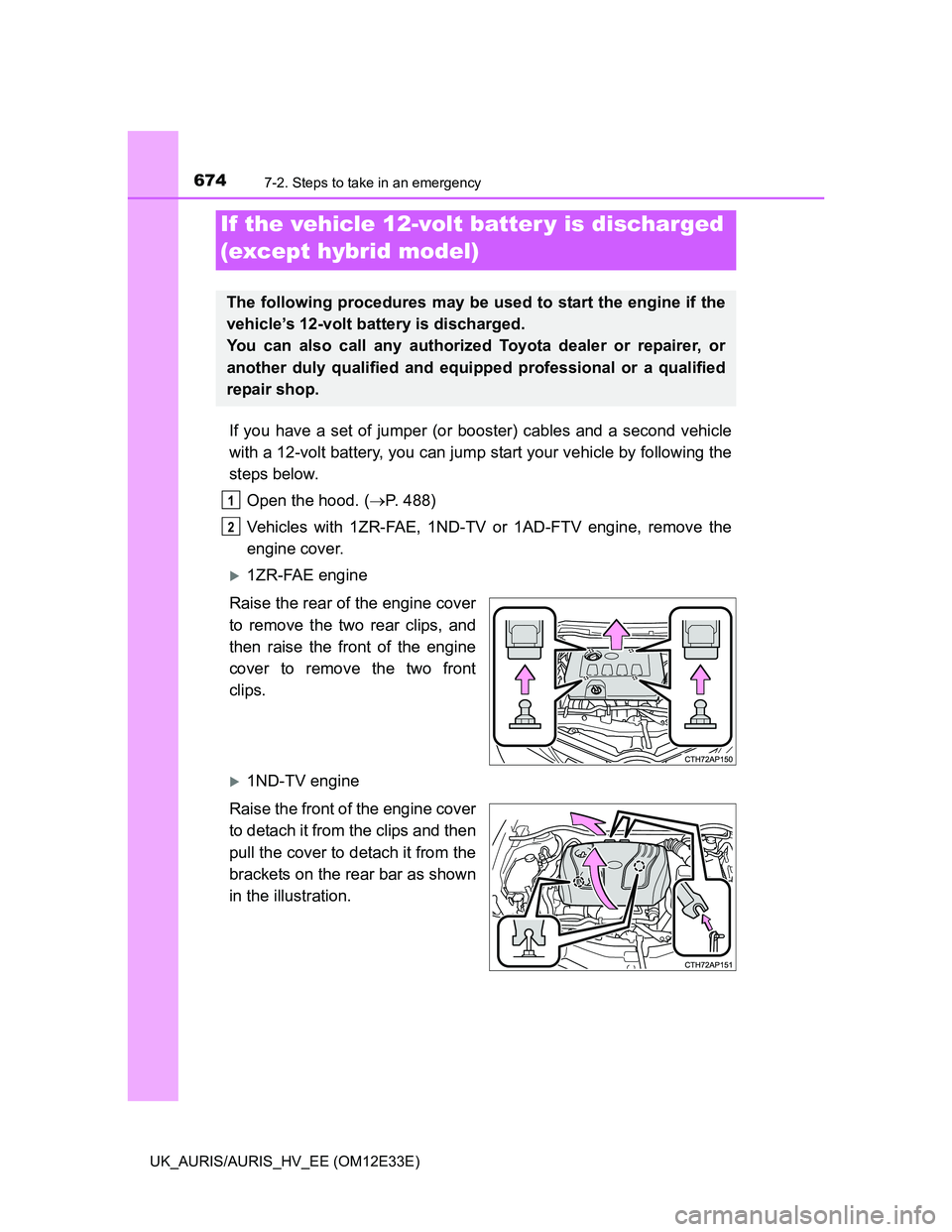
6747-2. Steps to take in an emergency
UK_AURIS/AURIS_HV_EE (OM12E33E)
If you have a set of jumper (or booster) cables and a second vehicle
with a 12-volt battery, you can jump start your vehicle by following the
steps below.
Open the hood. (P. 488)
Vehicles with 1ZR-FAE, 1ND-TV or 1AD-FTV engine, remove the
engine cover.
1ZR-FAE engine
Raise the rear of the engine cover
to remove the two rear clips, and
then raise the front of the engine
cover to remove the two front
clips.
1ND-TV engine
Raise the front of the engine cover
to detach it from the clips and then
pull the cover to detach it from the
brackets on the rear bar as shown
in the illustration.
If the vehicle 12-volt batter y is discharged
(except hybrid model)
The following procedures may be used to start the engine if the
vehicle’s 12-volt battery is discharged.
You can also call any authorized Toyota dealer or repairer, or
another duly qualified and equipped professional or a qualified
repair shop.
1
2
Page 679 of 750
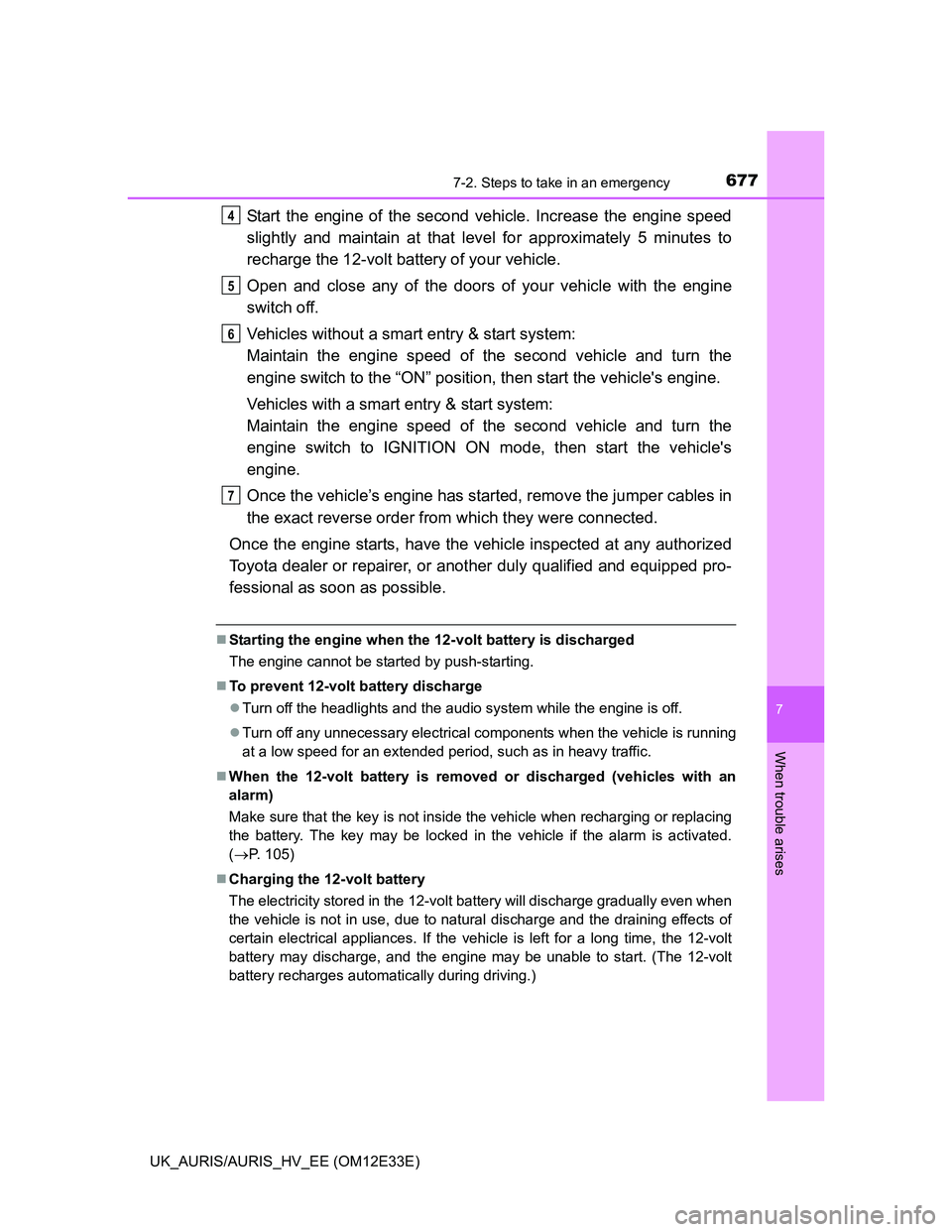
6777-2. Steps to take in an emergency
UK_AURIS/AURIS_HV_EE (OM12E33E)
7
When trouble arises
Start the engine of the second vehicle. Increase the engine speed
slightly and maintain at that level for approximately 5 minutes to
recharge the 12-volt battery of your vehicle.
Open and close any of the doors of your vehicle with the engine
switch off.
Vehicles without a smart entry & start system:
Maintain the engine speed of the second vehicle and turn the
engine switch to the “ON” position, then start the vehicle's engine.
Vehicles with a smart entry & start system:
Maintain the engine speed of the second vehicle and turn the
engine switch to IGNITION ON mode, then start the vehicle's
engine.
Once the vehicle’s engine has started, remove the jumper cables in
the exact reverse order from which they were connected.
Once the engine starts, have the vehicle inspected at any authorized
Toyota dealer or repairer, or another duly qualified and equipped pro-
fessional as soon as possible.
Starting the engine when the 12-volt battery is discharged
The engine cannot be started by push-starting.
To prevent 12-volt battery discharge
Turn off the headlights and the audio system while the engine is off.
Turn off any unnecessary electrical components when the vehicle is running
at a low speed for an extended period, such as in heavy traffic.
When the 12-volt battery is removed or discharged (vehicles with an
alarm)
Make sure that the key is not inside the vehicle when recharging or replacing
the battery. The key may be locked in the vehicle if the alarm is activated.
(P. 105)
Charging the 12-volt battery
The electricity stored in the 12-volt battery will discharge gradually even when
the vehicle is not in use, due to natural discharge and the draining effects of
certain electrical appliances. If the vehicle is left for a long time, the 12-volt
battery may discharge, and the engine may be unable to start. (The 12-volt
battery recharges automatically during driving.)
4
5
6
7
Page 680 of 750
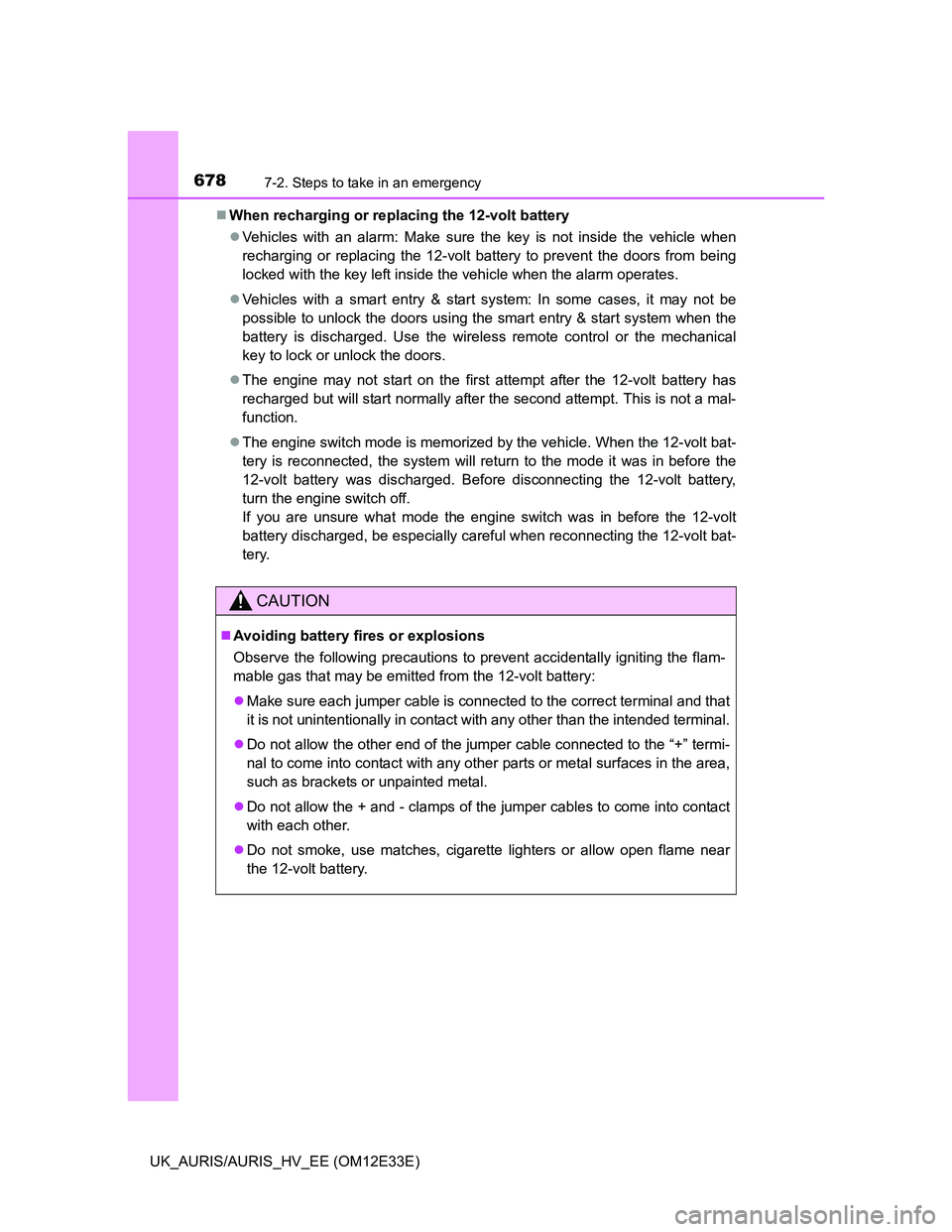
6787-2. Steps to take in an emergency
UK_AURIS/AURIS_HV_EE (OM12E33E)When recharging or replacing the 12-volt battery
Vehicles with an alarm: Make sure the key is not inside the vehicle when
recharging or replacing the 12-volt battery to prevent the doors from being
locked with the key left inside the vehicle when the alarm operates.
Vehicles with a smart entry & start system: In some cases, it may not be
possible to unlock the doors using the smart entry & start system when the
battery is discharged. Use the wireless remote control or the mechanical
key to lock or unlock the doors.
The engine may not start on the first attempt after the 12-volt battery has
recharged but will start normally after the second attempt. This is not a mal-
function.
The engine switch mode is memorized by the vehicle. When the 12-volt bat-
tery is reconnected, the system will return to the mode it was in before the
12-volt battery was discharged. Before disconnecting the 12-volt battery,
turn the engine switch off.
If you are unsure what mode the engine switch was in before the 12-volt
battery discharged, be especially careful when reconnecting the 12-volt bat-
tery.
CAUTION
Avoiding battery fires or explosions
Observe the following precautions to prevent accidentally igniting the flam-
mable gas that may be emitted from the 12-volt battery:
Make sure each jumper cable is connected to the correct terminal and that
it is not unintentionally in contact with any other than the intended terminal.
Do not allow the other end of the jumper cable connected to the “+” termi-
nal to come into contact with any other parts or metal surfaces in the area,
such as brackets or unpainted metal.
Do not allow the + and - clamps of the jumper cables to come into contact
with each other.
Do not smoke, use matches, cigarette lighters or allow open flame near
the 12-volt battery.
Page 682 of 750

6807-2. Steps to take in an emergency
UK_AURIS/AURIS_HV_EE (OM12E33E)
If you have a set of jumper (or booster) cables and a second vehicle
with a 12-volt battery, you can jump start your vehicle by following the
steps below.
Open the hood and fuse block
cover.
Open the exclusive jump start-
ing terminal cover.
If the 12-volt batter y is discharged (hybrid
model)
The following procedures may be used to start the hybrid sys-
tem if the 12-volt battery is discharged.
You can also call any authorized Toyota dealer or repairer, or
another duly qualified and equipped professional.
1
2
Page 683 of 750

6817-2. Steps to take in an emergency
UK_AURIS/AURIS_HV_EE (OM12E33E)
7
When trouble arises
Connect the jumper cables according to the following procedure:
Positive (+) battery terminal on your vehicle
Positive (+) battery terminal on the second vehicle
Negative (-) battery terminal on the second vehicle
Negative (-) battery terminal on your vehicle
Start the engine of the second vehicle. Increase the engine speed
slightly and maintain at that level for approximately 5 minutes to
recharge the 12-volt battery of your vehicle.
Open and close any of the doors of your vehicle with the power
switch off.
Maintain the engine speed of the second vehicle and start the
hybrid system of your vehicle by turning the power switch to ON
mode.
Make sure the “READY” indicator comes on. If the indicator does
not come on, contact any authorized Toyota dealer or repairer, or
another duly qualified and equipped professional.
Once the hybrid system has started, remove the jumper cables in
the exact reverse order from which they were connected.
Once the hybrid system starts, have the vehicle inspected at any
authorized Toyota dealer or repairer, or another duly qualified and
equipped professional as soon as possible.3
1
2
3
4
4
5
6
7
8
Page 684 of 750
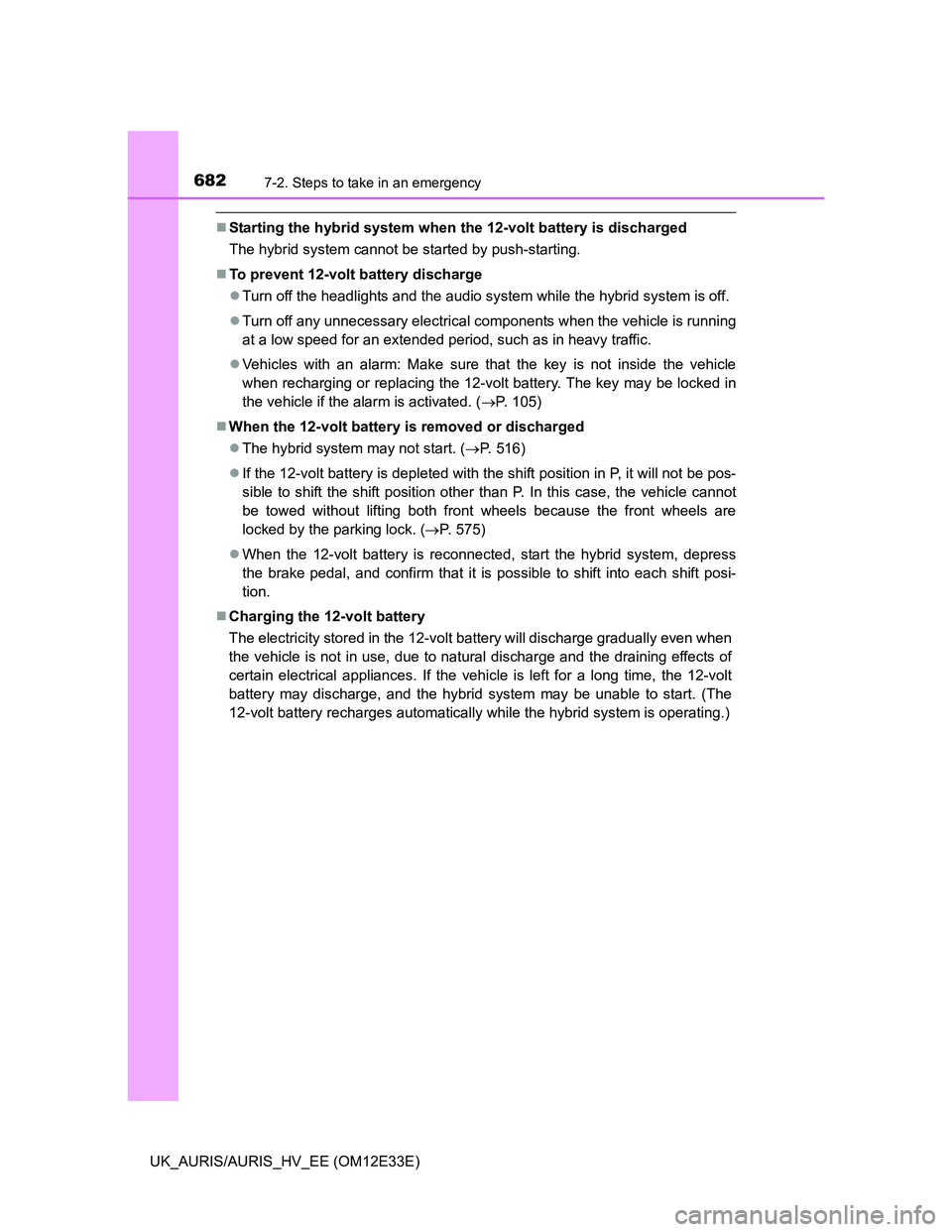
6827-2. Steps to take in an emergency
UK_AURIS/AURIS_HV_EE (OM12E33E)
Starting the hybrid system when the 12-volt battery is discharged
The hybrid system cannot be started by push-starting.
To prevent 12-volt battery discharge
Turn off the headlights and the audio system while the hybrid system is off.
Turn off any unnecessary electrical components when the vehicle is running
at a low speed for an extended period, such as in heavy traffic.
Vehicles with an alarm: Make sure that the key is not inside the vehicle
when recharging or replacing the 12-volt battery. The key may be locked in
the vehicle if the alarm is activated. (P. 105)
When the 12-volt battery is removed or discharged
The hybrid system may not start. (P. 516)
If the 12-volt battery is depleted with the shift position in P, it will not be pos-
sible to shift the shift position other than P. In this case, the vehicle cannot
be towed without lifting both front wheels because the front wheels are
locked by the parking lock. (P. 575)
When the 12-volt battery is reconnected, start the hybrid system, depress
the brake pedal, and confirm that it is possible to shift into each shift posi-
tion.
Charging the 12-volt battery
The electricity stored in the 12-volt battery will discharge gradually even when
the vehicle is not in use, due to natural discharge and the draining effects of
certain electrical appliances. If the vehicle is left for a long time, the 12-volt
battery may discharge, and the hybrid system may be unable to start. (The
12-volt battery recharges automatically while the hybrid system is operating.)
Page 685 of 750
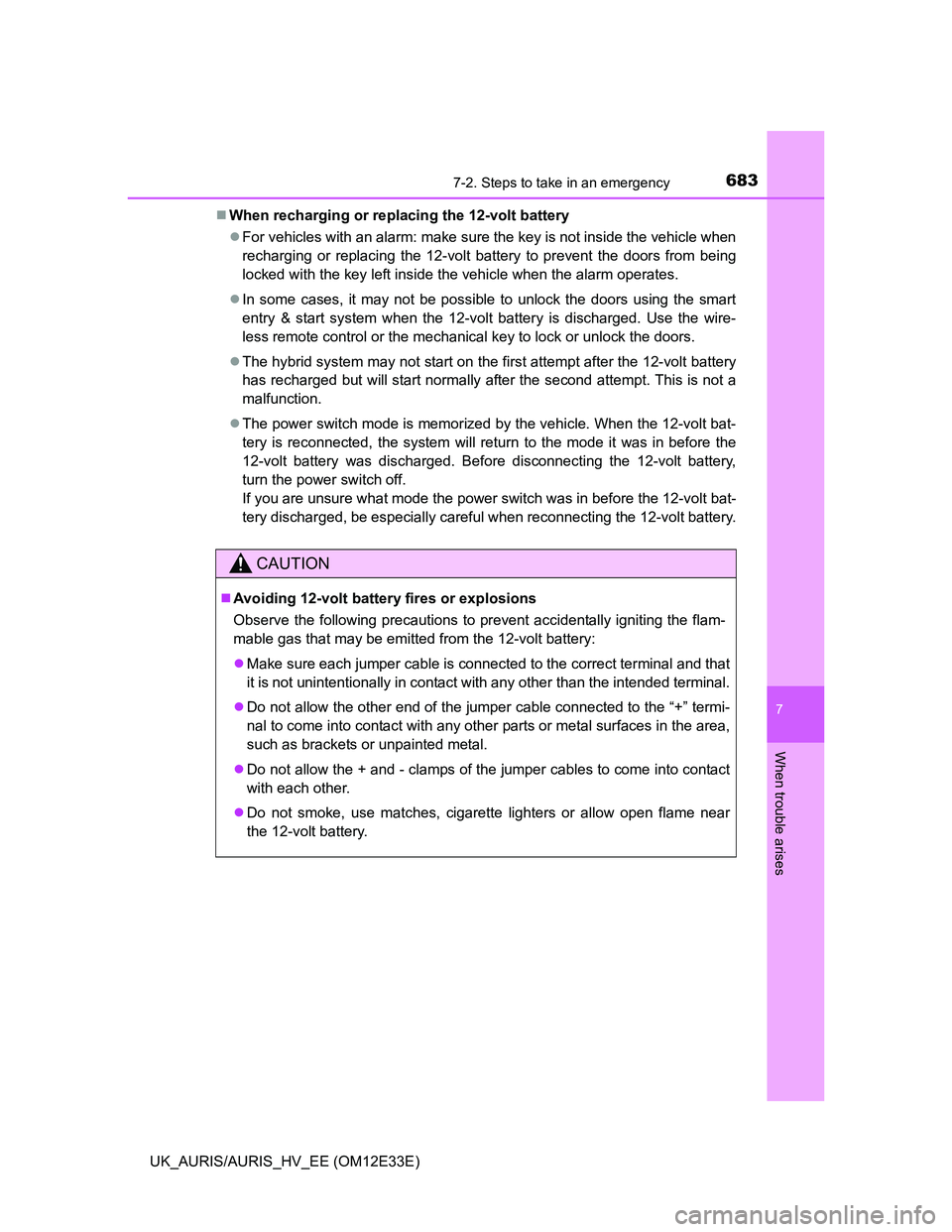
6837-2. Steps to take in an emergency
UK_AURIS/AURIS_HV_EE (OM12E33E)
7
When trouble arises
When recharging or replacing the 12-volt battery
For vehicles with an alarm: make sure the key is not inside the vehicle when
recharging or replacing the 12-volt battery to prevent the doors from being
locked with the key left inside the vehicle when the alarm operates.
In some cases, it may not be possible to unlock the doors using the smart
entry & start system when the 12-volt battery is discharged. Use the wire-
less remote control or the mechanical key to lock or unlock the doors.
The hybrid system may not start on the first attempt after the 12-volt battery
has recharged but will start normally after the second attempt. This is not a
malfunction.
The power switch mode is memorized by the vehicle. When the 12-volt bat-
tery is reconnected, the system will return to the mode it was in before the
12-volt battery was discharged. Before disconnecting the 12-volt battery,
turn the power switch off.
If you are unsure what mode the power switch was in before the 12-volt bat-
tery discharged, be especially careful when reconnecting the 12-volt battery.
CAUTION
Avoiding 12-volt battery fires or explosions
Observe the following precautions to prevent accidentally igniting the flam-
mable gas that may be emitted from the 12-volt battery:
Make sure each jumper cable is connected to the correct terminal and that
it is not unintentionally in contact with any other than the intended terminal.
Do not allow the other end of the jumper cable connected to the “+” termi-
nal to come into contact with any other parts or metal surfaces in the area,
such as brackets or unpainted metal.
Do not allow the + and - clamps of the jumper cables to come into contact
with each other.
Do not smoke, use matches, cigarette lighters or allow open flame near
the 12-volt battery.
Page 687 of 750

6857-2. Steps to take in an emergency
UK_AURIS/AURIS_HV_EE (OM12E33E)
7
When trouble arises
Stop the vehicle in a safe place and turn off the air conditioning sys-
tem.
Check to see if steam is coming out from under the hood.
If you see steam:
Stop the engine. Carefully lift the hood after the steam subsides and
then restart the engine.
If you do not see steam:
Leave the engine running and carefully lift the hood.
Check to see if the cooling fan is operating.
If the fan is operating:
Wait until the temperature of the engine (shown on the instrument
panel) begins to fall and then stop the engine.
If the fan is not operating:
Stop the engine immediately and call any authorized Toyota dealer
or repairer, or another duly qualified and equipped professional.
After the engine has cooled
down sufficiently, check the
engine coolant level and
inspect the radiator core (radia-
tor) for any leaks.
Add engine coolant if neces-
sary.
Water can be used in an emer-
gency if engine coolant is unavail-
able. (P. 709)
If your vehicle overheats (except hybrid
model)
1
2
3
4
5
Page 689 of 750
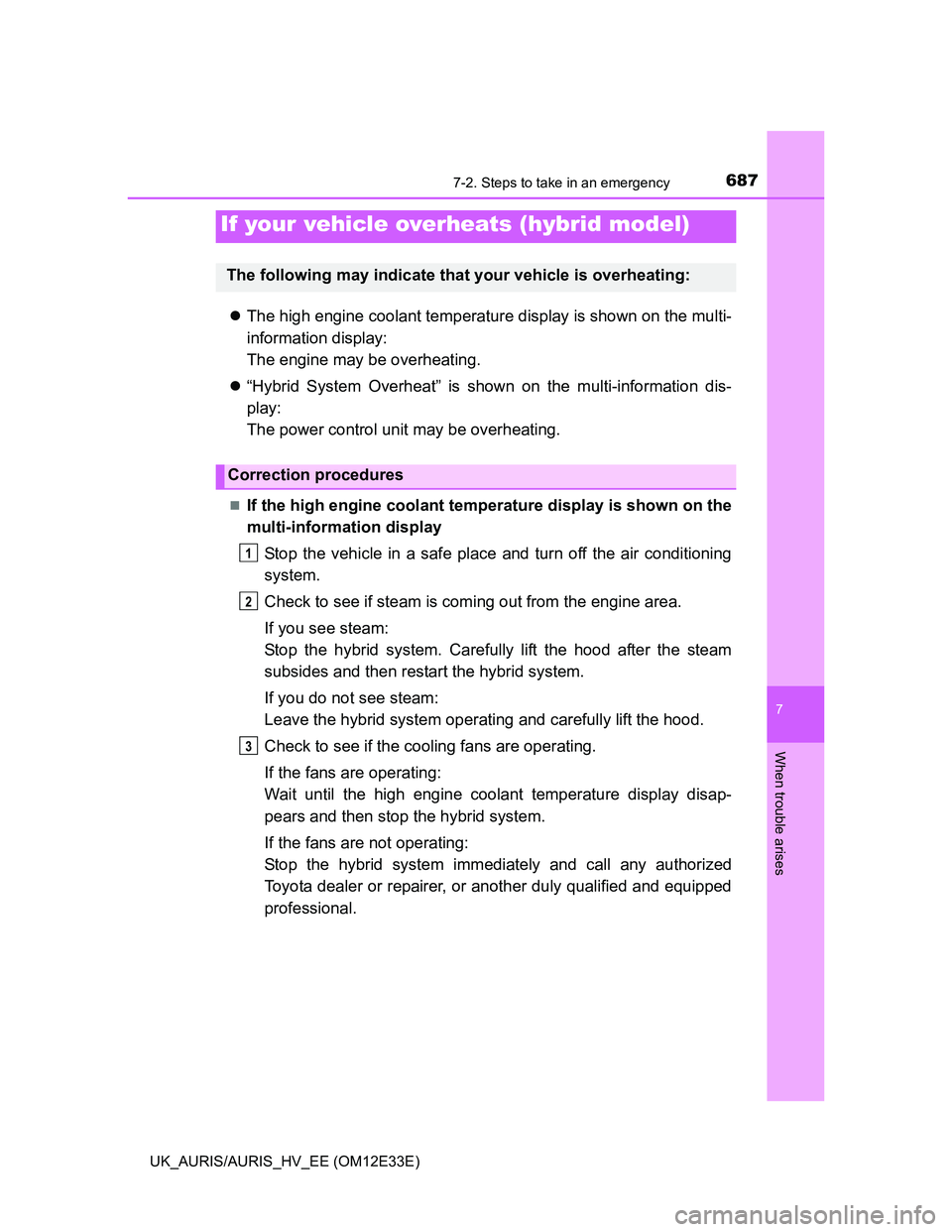
6877-2. Steps to take in an emergency
UK_AURIS/AURIS_HV_EE (OM12E33E)
7
When trouble arises
The high engine coolant temperature display is shown on the multi-
information display:
The engine may be overheating.
“Hybrid System Overheat” is shown on the multi-information dis-
play:
The power control unit may be overheating.
If the high engine coolant temperature display is shown on the
multi-information display
Stop the vehicle in a safe place and turn off the air conditioning
system.
Check to see if steam is coming out from the engine area.
If you see steam:
Stop the hybrid system. Carefully lift the hood after the steam
subsides and then restart the hybrid system.
If you do not see steam:
Leave the hybrid system operating and carefully lift the hood.
Check to see if the cooling fans are operating.
If the fans are operating:
Wait until the high engine coolant temperature display disap-
pears and then stop the hybrid system.
If the fans are not operating:
Stop the hybrid system immediately and call any authorized
Toyota dealer or repairer, or another duly qualified and equipped
professional.
If your vehicle overheats (hybrid model)
The following may indicate that your vehicle is overheating:
Correction procedures
1
2
3
Page 692 of 750
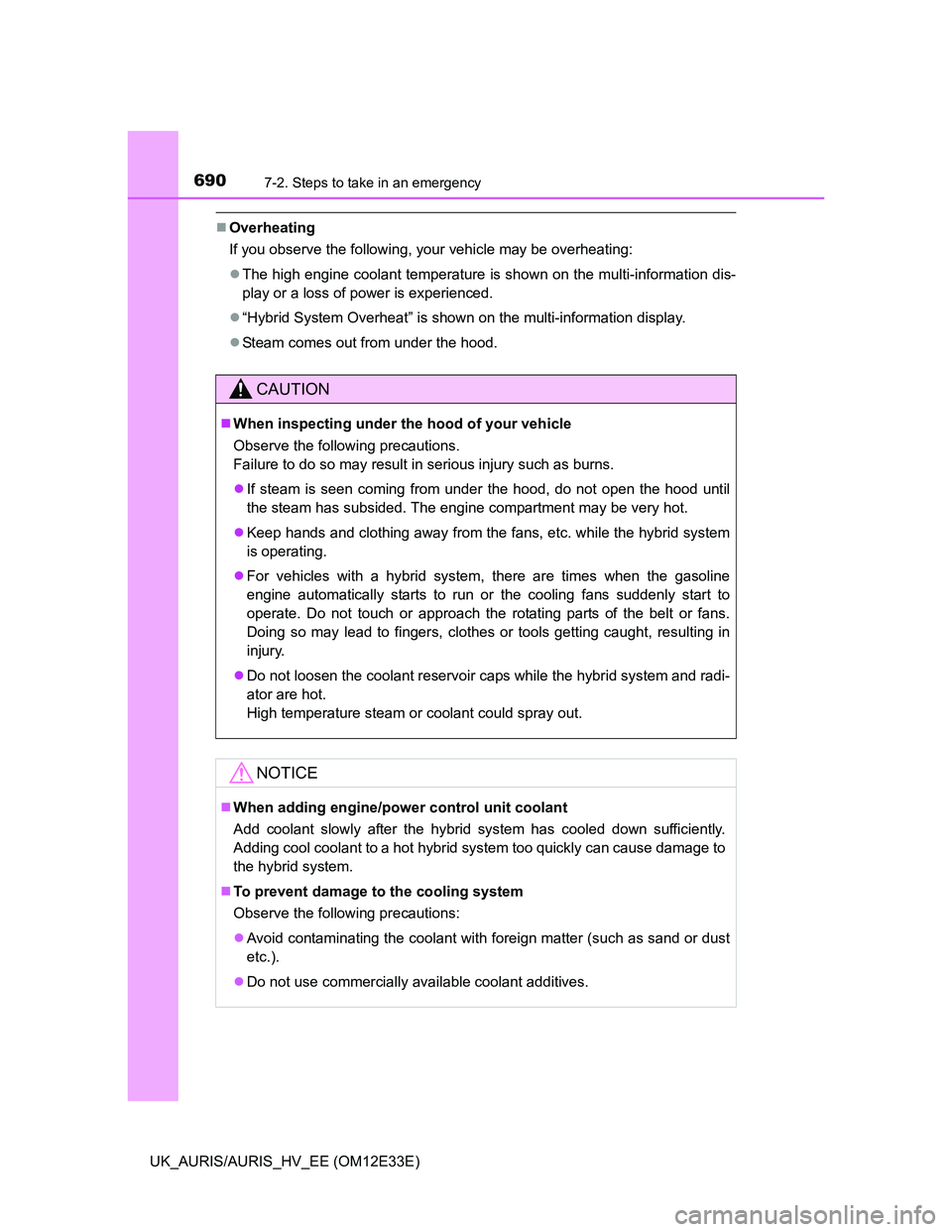
6907-2. Steps to take in an emergency
UK_AURIS/AURIS_HV_EE (OM12E33E)
Overheating
If you observe the following, your vehicle may be overheating:
The high engine coolant temperature is shown on the multi-information dis-
play or a loss of power is experienced.
“Hybrid System Overheat” is shown on the multi-information display.
Steam comes out from under the hood.
CAUTION
When inspecting under the hood of your vehicle
Observe the following precautions.
Failure to do so may result in serious injury such as burns.
If steam is seen coming from under the hood, do not open the hood until
the steam has subsided. The engine compartment may be very hot.
Keep hands and clothing away from the fans, etc. while the hybrid system
is operating.
For vehicles with a hybrid system, there are times when the gasoline
engine automatically starts to run or the cooling fans suddenly start to
operate. Do not touch or approach the rotating parts of the belt or fans.
Doing so may lead to fingers, clothes or tools getting caught, resulting in
injury.
Do not loosen the coolant reservoir caps while the hybrid system and radi-
ator are hot.
High temperature steam or coolant could spray out.
NOTICE
When adding engine/power control unit coolant
Add coolant slowly after the hybrid system has cooled down sufficiently.
Adding cool coolant to a hot hybrid system too quickly can cause damage to
the hybrid system.
To prevent damage to the cooling system
Observe the following precautions:
Avoid contaminating the coolant with foreign matter (such as sand or dust
etc.).
Do not use commercially available coolant additives.